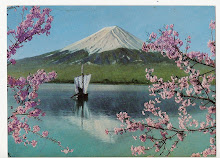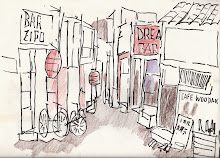ELECTRICITY LIGHTS UP RURAL JAPAN 1900S
The history of when and how the rural areas of Japan hooked up to electric power is long and complicated, a great subject for a college research paper.
Electric Power In Japan
Rapid electrification a century ago
Written by Mitsuyoshi Yamamoto and Mitsugi Yamaguchi
ILLUSTRATION by R.L.Huffstutter
Japan was opened to the world by U.S. Commodore Matthew C. Perry in 1854. Western culture, ideas, and technology soon permeated Japan, contributing to rapid modernization, including the establishment of electric light and power systems. Prof. W.E. Ayrton of the United Kingdom illuminated an electric arc light at a university campus in Japan for the first time in 1878. In 1882, Brush Company of the United States demonstrated lighting with a set of arc lamps in various places in Japan. The Japanese people, admiring the unfamiliar arc lights, said that the brightest light in the world is the sun, followed by the moon, and next the arc light.
In 1883, Tokyo Electric Light Company was founded and, in 1887, began service to the public using Thomas Edison's direct current (dc) system, 25-kW generators, and incandescent lamps. By 1890, more than 5,000 incandescent lamps were lit in Tokyo using power supplied by four power stations (one is shown in Figure 1). Other electric light companies were soon established in many areas of Japan. In 1889, the Electric Light Company in Osaka (the largest business center in the western region) introduced the Thomson-Houston 125-Hz single-phase 30-kW power system. The first hydroelectric power station in Japan, the Keage Power Station, was planned in 1888 in Kyoto City (the ancient capital of Japan near Osaka), and 19 generators were installed by 1897. The generators installed in Japan at that time were of various types because the most advanced equipment was being introduced with each new installation. Examples of these early generators are listed in Table 1.
The Keage Power Station is like a museum, exhibiting dc generators and alternating current (ac) generators with one to three phases and frequencies of 50, 60, 125, and 133 Hz. From the outset over a century ago, Japan introduced the most advanced power systems and machines for electric light and power only a few years later than the West. It was an era of revolutionary technological progress in power systems and remarkable developments in machinery, both in the West and in Japan.
The Era ofDC Power Systems
The commercial dc era began in the early 1880s when Edison demonstrated his "jumbo" bipolar generator to supply power to a dc lighting system. His power system was displayed at the Paris Electrical Exposition in 1881, receiving the highest praise and attracting great interest from foreign enterprises. Edison, taking advantage of this opportunity to increase sales, established subsidiary companies in many places in the United States and in many countries in Europe. It was only natural that Tokyo Electric Light Company, on recognizing the particular merits of Edison's power system, would initiate public utility service based on his idea.
At the Keage Power Station located in the middle of a canal, an inclined plane was placed to provide for the passage of boats. The first two sets of Edison's 80-kW dc generators were used primarily for the power supply to this equipment. This power station was planned according to the survey of the Aspen District in Colorado. In Aspen, there existed a hydraulic power station with dc generators that supplied power to a mining company to lift ore 304.8 m (1,000 ft).
Almost at the same time, the Keage Power Station installed four sets of Thomson-Houston single-phase 125-Hz 60- and 75-kW ac generators to meet the growing demand for light and power. Osaka Electric Light Company introduced the same type of 30-kW generators as well. This indicates that the era of Edison's dc power system ended in Japan after only a few years, beginning the era of ac power systems.
There were many pioneering efforts related to early power systems over the 30-year period before Edison introduced his dc bipolar dynamo. Notable among these efforts were the electromagnetic field for permanent magnets by H. Wilde (United Kingdom), the ring core by Z.T. Gramme (Belgium), the drum coil by F. von Hefner Alteneck (Germany), and the self-excitation dynamo by W. Siemens (Germany). However, further developments were necessary to permit the construction of modern generators. One such development was a multipolar circular magnetic field yoke which held coils in slots that could firmly support rectangular copper conductors. This improved magnetic circuit was used in 1895 when two sets of multipolar dc generators manufactured by General Electric were installed at the Keage Power Station to supply the first streetcars in Japan.
The most serious disadvantage of the early dc power system was the difficulty of changing voltage, the lack of long-distance power transmission capability, and the limited area of power supply. Because of these inherent problems, the dc power system had to yield to ac power systems.
The Era of AC Power Systems
There was debate over the usage of ac versus dc in the United States in the late 1880s and early 1890s. In the end, the supporters of ac were victorious. Manufacturing companies in this group included Westinghouse and Thomson-Houston (later General Electric after the merger with the Edison General Electric Company). In the 1880s, Westinghouse employed single-phase ac at a frequency of 133 Hz. Thomson-Houston supplied single-phase ac equipment operating at 125 Hz. Lighting constituted almost all of the load at that time, and the supply area was small, so the high frequencies of 125 and 133 Hz, advantageous for transformers, was favored. Ten-pole generators rotating at 1,000 rpm with a belt drive could generate power at a frequency of 133 Hz.
In 1886, William Stanley achieved the first United States demonstration of an ac lighting system using transformers at Great Barrington, Massachusetts. With this outcome, George Westinghouse decided to participate in the business of ac power and fabricated five kinds of standard light systems, namely, 500, 750, 1,500, 3,000, and 6,000 lamps with 16 candle power (cp) incandescent lamps. Of these, the 3,000 lamp system was commonly adopted at central power stations. Thomson-Houston's generator had three standard types: A35 (35-kW, 650 lamps), A70 (70-kW, 1,300 lamps), and A140 (140-kW, 2,600 lamps).
In Japan, there was also debate concerning the selection of dc or ac. Both the first generator at Osaka Electric Light Company and the third generator at Keage were operated with ac in 1891. The ac power system involves a danger of high voltage. However, the two companies employed Thomson-Houston single-phase 125-Hz generators, expecting the further development of ac systems and also exhibiting some sense of rivalry against Tokyo where the dc power system was more common at that time. It seems likely that Osaka Electric Light Company installed machine type A35, and Keage type A70.
The single-phase 125- or 133-Hz ac system of the early days became disadvantageous given the need for poly-phase power and lower frequencies. It was recognized that lower frequencies than 125 and 133 Hz would be desirable. While 125 and 133 Hz were somewhat better for transformers, a lower frequency than 60 Hz was considered better for power transmission and for rotary converters. In Europe, generators directly coupled with high-speed reciprocating engines (400–500 rpm) were considered, and such construction was eventually employed in the United States. For this type of generator, a frequency of 60 Hz would be desirable. For example, a 450-rpm, 16-pole generator would generate 60 Hz.
On the other hand, a lower frequency than 25 Hz is not suitable for incandescent lamps due to visible lamp flickering. A compromise between these contradictory conditions eventually led to the adoption of 60 Hz for general-purpose use and 25 Hz for transmission and rotary converters as the standard frequencies in the United States.
Westinghouse invited Nicola Tesla to be a consultant to his company and obtained exclusive rights to Tesla's polyphase ac system after Tesla's 16 May 1888 lecture to the AIEE on "A new system of alternate current motors and transformers." In 1893, Westinghouse won the contract to light the Chicago World's Fair and used this opportunity to display his two-phase universal system which consisted of six 1,000-hp 60-Hz generators, 300-hp induction motors, and rotary converters. This demonstration helped Westinghouse win the contract to build power facilities for the Niagara Falls Project. Westinghouse provided the first three 25-Hz, 5,000-hp, 2.2-kV, 250-rpm two-phase generators that were installed and put into operation at Niagara in 1895. In the following years, the Niagara Falls Project was greatly expanded.
In 1893, General Electric built the United States' first commercial three-phase ac system in Southern California for the Redlands Electric Light and Power Company. Pelton turbines drove two 250-kW hydroelectric generators. The power was transmitted 12.1 km (7.5 mi) to Redlands at 2.4 kV. In 1896, General Electric built a 35.5 km (22 mi) three-phase transmission line operated at 11 kV to transmit power to Buffalo, New York, from the Niagara Falls Project. The two-phase generated power was changed to three-phase by the use of Scott-T transformations.
Westinghouse was known in the 1890s as the advocate of the two-phase ac system, whereas General Electric favored the three-phase system. The primary reason Westinghouse preferred the two-phase system was the fact that almost all of the load was single-phase lighting, and power supply areas were limited in those days. In addition, the circuit was simple and there was merit in having only two transformers. However this situation changed with the widespread use of motors, including induction motors, and the necessity of long-distance transmission. As a result, three-phase systems came to dominate the power system market.
Another manufacturer, Stanley Electric Manufacturing Company, produced a two-phase ac system that was applied to the distribution of light and power at frequencies as high as 133 Hz. The generator was an inductor type with two-stator armature windings displaced by 90. The Keage Power Station introduced a two-phase Stanley system in 1894 to meet the power demand of light industries such as spinning, silk textile, metal foil working, and tobacco. These generators soon became obsolete, and three-phase replacement generators were imported in 1896 and 1897 from Siemens and General Electric.
Tokyo Electric Light Company introduced six three-phase, 50-Hz, 265-kW, 3-kV, 150-rpm generators in 1896 from Allgemeine Elektrizitäts Gesellschaft (AEG) in Germany and then, in 1896 and in 1897, Keage Power Station introduced three-phase, 60-Hz, 100- and 150-kW generators from General Electric and four three-phase, 50-Hz, 80-kW generators from Siemens.
****Moved***** to WordPress: phillipsblogs.blog
2 months ago














No comments:
Post a Comment